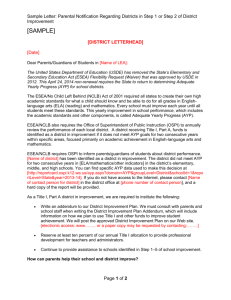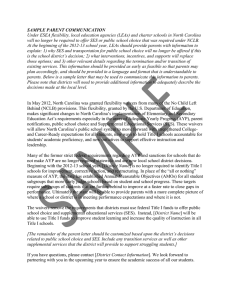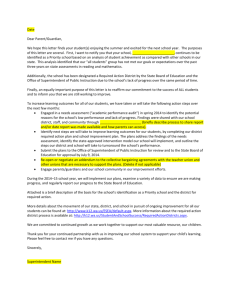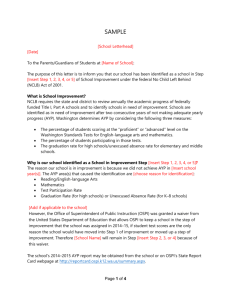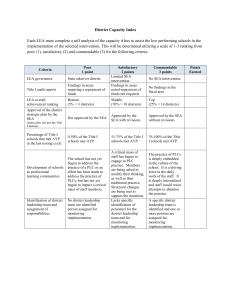Attachment B
advertisement
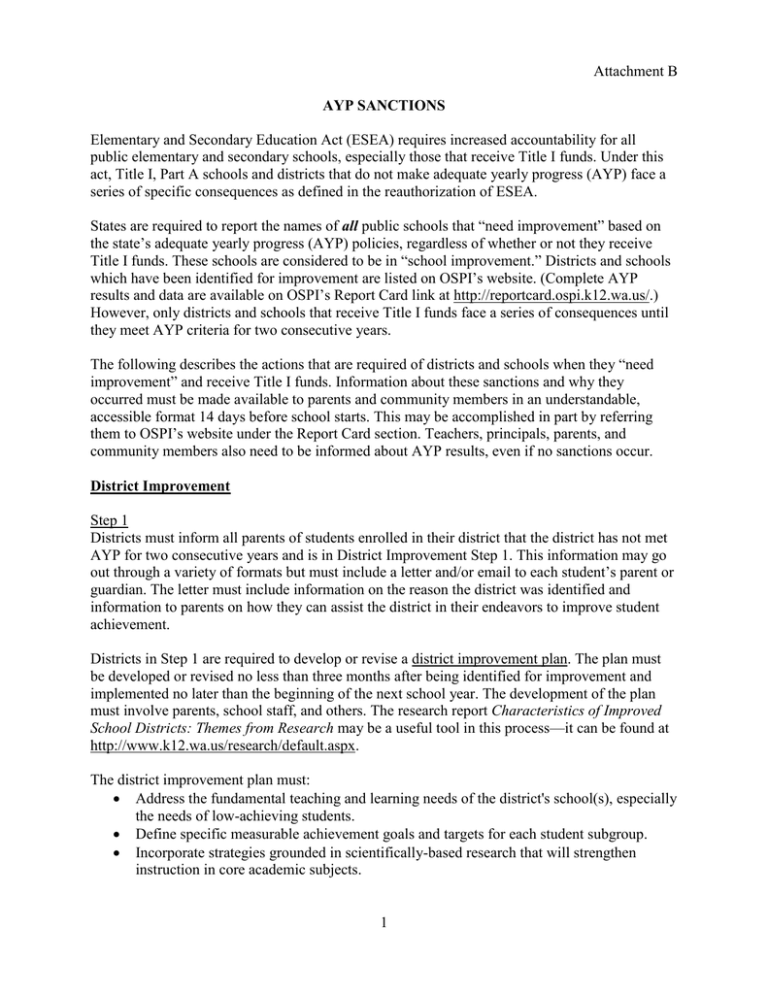
Attachment B AYP SANCTIONS Elementary and Secondary Education Act (ESEA) requires increased accountability for all public elementary and secondary schools, especially those that receive Title I funds. Under this act, Title I, Part A schools and districts that do not make adequate yearly progress (AYP) face a series of specific consequences as defined in the reauthorization of ESEA. States are required to report the names of all public schools that “need improvement” based on the state’s adequate yearly progress (AYP) policies, regardless of whether or not they receive Title I funds. These schools are considered to be in “school improvement.” Districts and schools which have been identified for improvement are listed on OSPI’s website. (Complete AYP results and data are available on OSPI’s Report Card link at http://reportcard.ospi.k12.wa.us/.) However, only districts and schools that receive Title I funds face a series of consequences until they meet AYP criteria for two consecutive years. The following describes the actions that are required of districts and schools when they “need improvement” and receive Title I funds. Information about these sanctions and why they occurred must be made available to parents and community members in an understandable, accessible format 14 days before school starts. This may be accomplished in part by referring them to OSPI’s website under the Report Card section. Teachers, principals, parents, and community members also need to be informed about AYP results, even if no sanctions occur. District Improvement Step 1 Districts must inform all parents of students enrolled in their district that the district has not met AYP for two consecutive years and is in District Improvement Step 1. This information may go out through a variety of formats but must include a letter and/or email to each student’s parent or guardian. The letter must include information on the reason the district was identified and information to parents on how they can assist the district in their endeavors to improve student achievement. Districts in Step 1 are required to develop or revise a district improvement plan. The plan must be developed or revised no less than three months after being identified for improvement and implemented no later than the beginning of the next school year. The development of the plan must involve parents, school staff, and others. The research report Characteristics of Improved School Districts: Themes from Research may be a useful tool in this process—it can be found at http://www.k12.wa.us/research/default.aspx. The district improvement plan must: Address the fundamental teaching and learning needs of the district's school(s), especially the needs of low-achieving students. Define specific measurable achievement goals and targets for each student subgroup. Incorporate strategies grounded in scientifically-based research that will strengthen instruction in core academic subjects. 1 Include appropriate student learning activities before school, after school, during the summer, and during any extension of the school year. Provide for high-quality professional development for instructional staff that focuses on improved instruction. Include strategies to promote effective parental involvement in the district's schools. Include a determination of why the district's previous plan did not bring about the required increase in student academic achievement. A district identified for improvement must allocate ten (10) percent of its Title I budget to address the professional development needs of teachers who work with the student groups that have not met AYP. If a district requests technical assistance from the state, the state is required to provide this assistance. The technical assistance provided by OSPI must be supported by effective methods and instructional practices that are founded on scientifically-based research. Step 2 The district must inform parents of the district’s adequate yearly progress and that they have moved into Step 2. The information must be provided in a written format and may also go out in alternative formats. Information on the reasons why the district moved into Step 2 must be explained, and the steps for implementing the district improvement plan must be provided. A description on how parents may assist the district must also be included. Districts in Step 2 of improvement are required to implement the district improvement plan that was developed in Step 1 by the beginning of the school year. The district must clearly address the actions that they have worked on with the state that will be implemented. The state must continue to ensure the district is provided with technical assistance and must take at least one of the following corrective actions, as consistent with state law: Defer program funds or reduce administrative funds. Institute and fully implement a new curriculum based on state and local content and academic achievement standards that includes scientifically research-based professional development for all relevant staff. In conjunction with at least one of these actions, the state may also authorize parents to transfer their student from a school operated by the district to a higher-performing school that is not identified for improvement. School Improvement Step 1 Schools in this category have not made AYP for two consecutive years in the same subject and are considered to be in Step 1 of school improvement. Fourteen days before school starts, schools that receive Title I funds must notify the families of enrolled students about the opportunity to transfer their student to another school in the same district that is not identified for school improvement. (Sample letters are on OSPI’s website at http://www.k12.wa.us/titleI/sampleletters.aspx.) Letters must be sent even if there is not an option for transfer. The letter must explain that there is no option. 2 Districts must use up to an amount equivalent to 20 percent of their Title I, Part A budget (unless a lesser amount is needed) to fund public school choice. Transportation costs (within federal parameters) must be covered by the district for families exercising this option. The school must also develop or revise its school improvement plan. The plan must be completed no later than three months after the school is identified for school improvement. Guidance for the letter and the school improvement plan are in the ED LEA and School Improvement Non-Regulatory Guidance at http://www.ed.gov/programs/titleiparta/legislation.html. Step 2 Schools in Step 2 of school improvement must continue school improvement planning. The district must continue to offer public school choice and must also provide supplemental educational services (SES) to low-income students who are considered low-achieving (e.g., qualify for free/reduced lunch). Parents select SES providers from OSPI’s state approved list of SES providers. (The approved providers list is available on OSPI’s website at http://www.k12.wa.us/TitleI/SES.aspx.) Districts must use an amount equivalent to 20 percent of their Title I budget (unless a lesser amount is needed and the district has approval from OSPI to reallocate the set-aside) to fund public school choice and SES. Step 3 Districts with schools in Step 3 (“corrective action”), must select at least one of the following options (and identify their own actions): Make curriculum and instruction changes to improve student learning. Appoint outside experts to work to advise the school on revising and implementing the school plan. Extend the school year or school day. In addition to taking a corrective action, the district must continue to offer public school choice and supplemental educational services, and the school must revise the school improvement plan. The plan must include a description of the corrective action the school has instituted and how this action will lead to student success on the state’s assessment measures. Step 4 In this step, school districts are required to address “school restructuring” which means a major reorganization of the school’s governance. The district has one year to prepare a restructuring plan. Parents and teachers must be provided information that the school has entered Step 4 and provided the opportunity to comment on the proposed restructuring actions and assist in the development of the restructuring plan. The plan must be implemented and instituted no later than the beginning of the following school year, whether or not the school has moved into Step 5. The restructuring plan needs to include at least one of the following three actions: Replace school staff members, which may include the school principal, who are relevant to the school's inability to meet standards. Enter into a contract with an outside entity with a demonstrated record of effectiveness, to operate the school. Implement other restructuring activities that are consistent with the principles of restructuring. 3 The district must provide technical assistance that emphasizes (a) the importance of improving instruction by using strategies grounded in scientifically-based research so that all students achieve proficiency in the core academic subjects of reading and mathematics, and (b) the importance of analyzing and applying data in decision-making. The district must also continue to offer public school choice and SES to all eligible students. Step 5 In this step, the district must ensure that the school in Step 5 has implemented the school’s restructuring plan. The district must also continue to offer public school choice and SES to all eligible students. For more information on AYP sanctions, please contact the Title I/LAP office at (360) 725-6100. 4

